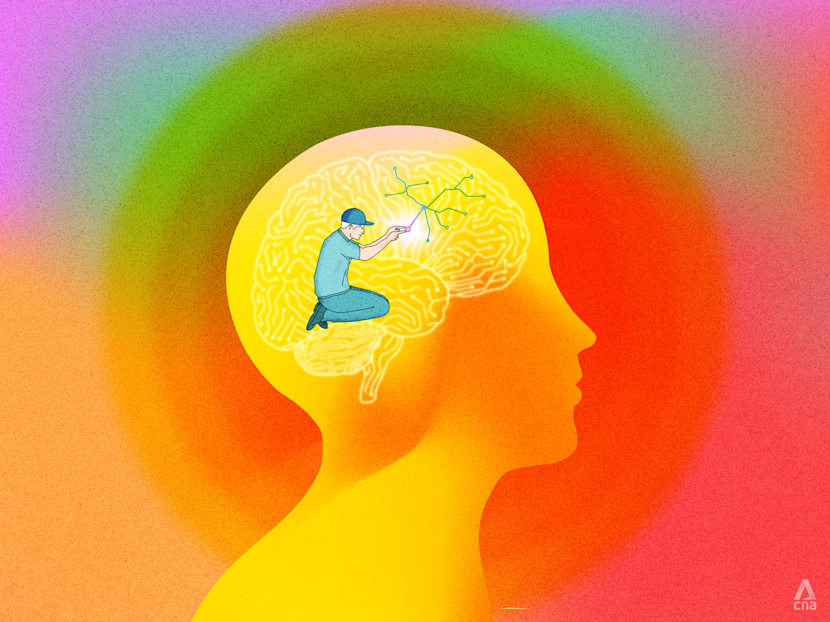'I'm manifesting': Does science back the idea we can think our way to positive outcomes?
Manifestation may sound like pseudoscience, but experts say visualising goals and repeating affirmations can activate the brain's motivation circuits and, when belief is paired with action, help shape real outcomes.

Visualising success and repeating affirmations activate the brain's reward and motivation circuits, prompting goal-driven behaviour. (Illustration: CNA/Samuel Woo)

This audio is generated by an AI tool.
Scrolling through TikTok or Instagram, it doesn't take long to stumble on posts preaching the power of "manifestation".
Whether it's career success, finding love or basking in all things good, manifestation – as popularised by social media gurus – is often presented as a kind of cosmic law: the belief that thinking, saying and visualising what you want hard enough can turn such aspirations into reality.
Needless to say, the practice has its fair share of critics quick to dismiss it as pseudoscience or just a whole lot of woo-woo.
But neuroscientists and psychologists argue that while manifestation isn't magic, there is some basis to the concept that taking charge of our thoughts in a constructive way can influence our actions and, in turn, our outcomes.
In fact, what social media calls "manifesting" might just be a popular rebranding of what scientists have long studied through neuroplasticity, or the brain's ability to change and adapt through experience and thought.
"The concept of 'manifestation' often elicits scepticism," says Dr Natasha Mitter, principal clinical psychologist at Us Therapy Singapore.
"But its core practices – that of visualisation, affirmations and intentional focus – in fact mirror evidence-based strategies in psychology and neuroscience.
"The brain is not static; it is shaped by repeated thoughts, behaviours and emotional experiences. These techniques can therefore activate motivation and reward pathways, reshape neural circuits through neuroplasticity, and prime the brain for goal-directed action."
The late Dr James Doty, a clinical professor of neurosurgery and founding director of the Stanford Center for Compassion and Altruism Research and Education in the United States, noted in a book that our attention can be intentionally redirected to reshape the brain's neural pathways.
His 2024 publication titled Mind Magic: The Neuroscience of Manifestation and How It Changes Everything stated that it's possible to strengthen the brain's grey matter – the neural tissue linked to learning and cognitive growth – and, in doing so, unlock more of one's potential.
Accepting that not all forms of manifestation are mere pseudoscience, how do techniques like positive affirmations and visualisation actually work – and what are the best ways to practise them?
THE SCIENCE OF MANIFESTATION
Experts say that when we imagine success, repeat affirmations or visualise our goals, we are not conjuring magic, but activating the brain's reward and motivation circuits.
This, in turn, primes the brain to pursue actions that move us closer to achieving those goals.
Dr Jean Liu, associate professor of psychology at the Singapore Institute of Technology (SIT), said: "It is well established that thoughts influence behaviour, which directly affects outcomes."
This, she added, is a key tenet of cognitive behaviour therapy in clinical psychology. Challenging negative beliefs or expectations – such as anticipating the worst that might happen – can help people feel more motivated and better equipped to work towards their goals.
Professor Annabel Chen, a clinical neuropsychologist and director of the Centre for Research and Development in Learning at Nanyang Technological University (NTU), pointed to the results of brain imaging studies.
She said that they show that when people think positively about themselves or their goals, parts of the brain linked to motivation and reward light up – particularly the ventral striatum and prefrontal cortex, which govern decision-making and attention.
"The ventromedial prefrontal cortex, in particular, is consistently activated during self-affirmation tasks," said Prof Chen.
"It helps us link new goals with our personal values and essentially tells the brain: 'This matters to me'."
When the ventromedial prefrontal cortex works in tandem with reward circuits, the brain assigns higher motivational value to a goal, making it more likely for us to take concrete steps to follow through.
"These same regions help us decide what is worth doing. So, when you visualise your goals, your brain starts treating them as more important and making you more likely to take action," said Prof Chen.
In fact, Dr Mitter from Us Therapy said that the act of visualisation employs many of the same neural pathways as actual experience.
In other words, mentally rehearsing a movement or action can activate the motor cortex almost as if you were physically performing it.
This is a technique athletes use all the time: picturing a flawless serve or sprint engages the brain's motor regions much like the actual motion itself.
SIT's Dr Liu explained that the act of visualisation allows us to vividly imagine a scene or object in detail. Research using functional magnetic resonance imaging has found that this activates many of the same brain regions as actually seeing the real thing.
"In essence, we are essentially conditioning our minds to align with a desired reality," said Dr Mitter.
As the brain learns through repetition, NTU's Prof Chen added that, over time, these repeated mental rehearsals strengthen neural connections, making it easier to act with confidence and focus.
Dr Mitter said: "Thanks to neuroplasticity, repeated affirmations and visualisations strengthen the connections between neurons – the tiny 'message-sending' cells that make up your brain and body – making adaptive thought patterns more automatic over time.
"From a neuroscience perspective, the more we repeat certain thoughts, the stronger the brain connections supporting them become," she said.
Dr Mitter cautioned that this goes both ways: whether it's through the repetition of positive affirmations or the reinforcement of negative self-beliefs.
Dr Chen calls it a "feedback loop" where the brain learns from what you feed it, whether that's hope or doubt.
Positive affirmations can also help manage stress, which in turn makes it easier to stay on task in challenging situations, said SIT's Dr Liu.
"Individuals who use affirmations show lower cortisol levels and better stress regulation. In educational settings, self-affirmation can lead to improvements in both well-being and academic achievement for students," said Dr Liu.
"Goal-directed self-talk is used by athletes and leaders to encourage them to stay on task and focus in challenging situations. Research has found that this can help them to regulate emotions and concentration – even during crises or under stress."
PAIR BELIEF WITH BEHAVIOUR
That said, how can one harness the benefits of manifestation without drifting into pseudoscience? The experts suggested a few evidence-backed approaches.
- Keep goals realistic and specific
A good starting point is to be clear about what you want and how you will get there.
Setting concrete, achievable goals activates the brain's motivation circuits and prevents one from getting discouraged if one is unable to achieve a desired outcome.
Prof Chen said: "If you believe a goal is realistic and important, your brain releases the right mix of motivation signals to help you stay focused and persistent."
On the other hand, the brain recognises when a goal feels too far-fetched – like mastering a new language in a week – and may see it as impossible, which in turn diminishes motivation to act.
"That's why it's important to set realistic, step-by-step goals," said Prof Chen.
"Thinking through how you'll get there, and adjusting your plan as you go, keeps your brain motivated and makes progress feel rewarding."
- Use empowering language where you hold agency, not others
While phrases such as: "May the universe have my best interest at heart" have gained traction among manifestation enthusiasts on social media, experts emphasise the importance of using empowering language – particularly, words that place agency in your own hands, rather than leaving outcomes to external forces.
"The key is to focus on what you can do, not what might happen to you," said Dr Mitter, adding that affirmations are most effective when they are self-directed, specific and grounded in personal agency.
For example, affirmations should focus on what one can actually do or change.
"Phrases like: 'I can handle challenges' or: 'I will take steps toward my goal' activate brain regions linked to motivation and self-efficacy. In contrast, passive phrases like: 'The universe will provide' may feel comforting but do not activate the brain's motivation and action systems in the same way," said Dr Mitter.
- Repetition matters and verbal articulation makes a difference
As the brain adapts through repetition, consistently practising affirmations helps strengthen the neural circuits that support new beliefs and behaviours.
Dr Mitter likened this process to building a muscle, where the more often one activates a particular thought pattern, the stronger and more automatic it becomes.
Furthermore, there is also value in verbally articulating these positive affirmations.
Dr Mitter said: "The articulation of affirmations engages the brain's linguistic processing centres, while their actual content stimulates neural regions associated with emotional regulation and memory.
"When combined with imagery, this creates a powerful mental imprint that strengthens belief and motivation. With repetition, it can gradually shift your brain’s default thinking patterns toward more positive and encouraging narratives."
- Pair belief with behaviour
Experts also stressed the importance of pairing positive affirmations with concrete action to turn intention into outcome because thought alone won't create real change.
While belief helps one to start, it is action and consistency that makes change happen, said Prof Chen.
"Manifestation has a real scientific basis but it's rooted in motivation, neuroplasticity, and behaviour, not magic. And it works best when it's realistic, action-based, and consistent," said Prof Chen.
"Our thoughts activate networks that shape what we focus on, how we plan, and how much effort we invest. But true change happens when thought becomes consistent, realistic action.
"Positive thinking helps your brain focus, plan and stay motivated, but it's the doing, not just the thinking, that changes outcomes."
- Give it time
The experts emphasised that ultimately the brain does not rewire itself overnight. Lasting change takes time – often weeks or even months of consistent, repeated effort – to effect.
What matters most, however, is staying the course with consistency.
When affirmations are paired with sustained effort, and the brain's neural pathways begin to rewire in a positive direction, it becomes increasingly natural for the mind – and behaviour – to keep moving that way.
"With time, these patterns can become part of the brain's 'automatic wiring', shaping how we think, feel, and respond without conscious effort," said Dr Mitter.
At its core, Dr Mitter argued, manifestation isn’t a "mystical shortcut" but "neuroplasticity in motion".
"Neuroplasticity does not mean instant transformation; it simply means the brain can change, but it takes consistent repetition, emotional impact, and effort to reshape how it works.
"By repeatedly directing our attention and emotions toward a goal, we strengthen the brain pathways that make it easier to act in accordance to that goal."












